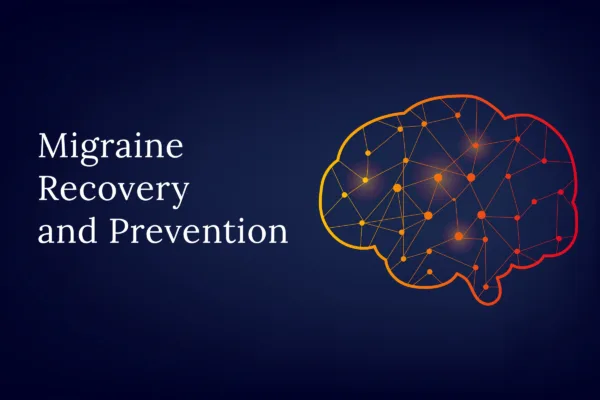What are migraines?
Migraine is a complex headache disorder which is characterized by recurrent episodes of strong headaches. Most often, migraines occur on one side of the head (this phenomenon is also called unilateral migraines). In some individuals, migraines are associated with visual or sensory symptoms referred to as an “aura,” which often occur before the headache onset, but in some individuals, “aura” may occur during or after the headache.
In addition, symptoms such as nausea, vomiting, cognitive impairment and blurred vision are frequently reported among migraine sufferers. After the migraine has resolved, many migraine sufferers experience the symptoms of fatigue or irritability.
According to a report released by Statistics Canada on the prevalence of migraines, approximately 2.7 million Canadians (or 8.3% of the population) suffer from migraines. Further, most of the individuals suffering from migraines report that migraines prevented them from having a good night’s sleep, and also kept them from driving. In addition, 26% of migraine sufferers reported that migraines prevented them from their normal daily activities.
What are the causes of migraines?
Although migraines seem to be caused by a complex interaction of environmental and genetic factors, migraines have a strong genetic component. Scientific research shows that approximately 70% of migraine sufferers have a first-degree relative with a history of migraines, and that the risk of migraines is increased by 4 times in family members of individuals who suffer from migraines with aura.
Migraine triggers
In addition to genetic causes of migraines, a number of migraine triggers have been identified. A migraine trigger can be defined as any event, change, external or internal factor, or physical act, that can cause a migraine. Although there is no universal migraine trigger which affects every single migraine sufferer, many migraine sufferers are aware of some of the factors which may trigger their migraines.
These include stress, insufficient or excessive sleep, certain types of medications, smoking, strong odours, exposure to some types of bright lighting (including fluorescent), skipping meals, and smoking.
In addition, a number of foods and food ingredients have been identified as migraine triggers. These include red wine, caffeine, monosodium glutamate (MSG), foods containing large amounts of the molecule tyramine (such as aged cheeses), citrus fruit, and artificial sweeteners (including aspartame and saccharine).
Why should you keep a migraine journal?
If you suffer from recurrent migraines, keeping a detailed journal of your migraine episodes can help to provide you with additional insight on how to prevent and avoid them. Recording the patterns, severity and preceding symptoms of your migraines can help your physician to come up with a more accurate diagnosis, and to help to select the appropriate treatment.
Some useful information to write down in your migraine journal includes:
- Date of the migraine
- The duration of the migraine (time of start and finish)
- Pain intensity of the migraine (rating from 1-10)
- Preceding symptoms (including aura and any other physical symptoms)
- Triggers which may have caused the migraine
- Medication taken and the dose
- Relief achieved with medication (rating from 1-10)
In your personal migraine journal, it is generally a good idea to also record aspects of your daily life which may have contributed to the frequency or severity of your migraines. For example, it is important to record any medications or vitamin supplements you are taking, how much sleep you are getting and how much you are exercising.
It can also be helpful to note your stress levels and weather changes, as both have been demonstrated to trigger migraines. For women, it is also important to record the details of their menstrual cycle, as hormonal influences play a role in triggering headaches as well.
Migraine patterns
For each migraine sufferer, it is important to identify migraine his or her migraine triggers and patterns. For instance, women who suffer from migraines can often discern their migraine pattern due to hormonal fluctuations.
Migraine patterns can change over one’s lifetime, and in women, migraines are typically more severe at menarche and during the menstrual period, with some fluctuations in improvement or worsening during pregnancy or menopause.
In many migraine sufferers, migraine headaches tend to improve in their 50s and 60s, and sometimes become replaced with aura symptoms experienced without headache pain.
Why should I keep a food diary in addition to my migraine diary?
Diet can play an important role in the frequency of migraine occurrence. Not all foods associated with triggering migraines will cause migraines in every single person, and personal food triggers can be difficult to pinpoint. Therefore, keeping a food diary along with a migraine diary can help migraine sufferers to keep track of foods they ate prior to their migraine episodes in order to identify their personal food triggers.
Although some foods can trigger a migraine almost immediately, others can take up to 24 hours to cause a headache, and a food diary can be a very helpful tool to keep track of your personal triggers. It is also important to note any skipped meals, as this is known to be a potential migraine trigger.
By keeping a detailed migraine and food diary, you and your health practitioner can better identify the pattern of your migraine attacks. The effects of your dietary habits and lifestyle factors on triggering migraines can also become clear when examining your migraine journal.
Conclusion
Keeping a migraine journal can be extremely helpful to both you and your health practitioner in determining the effectiveness of both preventive treatments and medications. It is very easy to overlook subtle changes in the frequency, duration and severity of migraines, as well as any improvements in your condition.
By keeping track of your migraines using a journal, you can enough information about your migraine patterns while taking a specific medication or undergoing a treatment in order to determine its effectiveness.
There are many free resources available online to help migraine sufferers to identify their migraine symptoms and track their migraine patterns. Here are some free templates of headache/migraine journals provided by different health authorities.
Harvard Medical School: https://www.health.harvard.edu/headache/keeping-a-headache-diary
National Headache Foundation: https://headaches.org/resources/headache-diary-keeping-a-diary-can-help-your-doctor-help-you/
WebMD: https://www.webmd.com/migraines-headaches/headache-diary


















